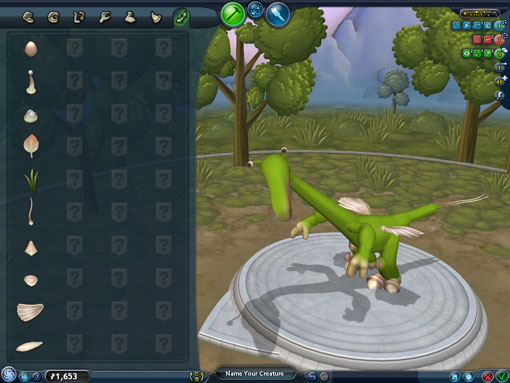Reviews: Puts the power of MichelangeloЧor Dr. FrankensteinЧin your hands
Games are about interactivity and creativityЧthey're what sets them apart from linear media like movies and books. We want to get in and get involved in the story, to affect how things happen from one moment to the next. We want to figure out a better way to do things based on the tools we're given, whether they're tank units in an RTS or a magic sword in an RPG. If we wanted to be told how the battle, story, or football game turned out, we'd watch it on television. Spore, the upcoming game from master designer Will Wright and his studio Maxis, is set to give players the creative freedom to design every aspect of the characters they'll play. In anticipation of the day Spore drops, Maxis has released the Spore Creature Creator, a tool that allows players to test-drive a small part of the game.
The Spore Creature Creator starts its player with nothing but a body, a spine and a few tools. It's clear that Maxis has put a lot of work into making the tools as simple to use as possibleЧthere are a pair of arrows that can be used to extend the neck or tail of the creature, while clicking and dragging an individual vertebra allows you to manipulate the shape and height of your creature. It's truly impressive to watch the body expand and contract and bend to your will that first time. Drag one of the arrows and you can add vertebrae to the neck or tail. There's vertebra budget, though, so you can't really make a giraffe with an alligator tail. There's plenty of freedom, though, to curve the neck, body and tail to create a pleasing design. You can even add girth to your creature with a simple spin of the mouse wheel.

Once you've got a general body shape, you'll want to add parts. Body parts not only help make your creature look like something that could live and breatheЧthey also add traits and character to the beast. For instance, the choice of mouth determines whether the creature will be carnivore or herbivore. There are seven different categories of parts, ranging from essentials like limbs to decorations that include various spikes, feathers, and so on. It feels somewhat like building a character in a traditional RPG, since each added part affects the creature's stats. A good set of feet, for instance might give a boost to speed and dancing ability, while also adding oompf to the creature's charge attack. A smattering of feathers or other decoration might improve the creature's charm.
Also like an RPG, the player starts out with a budget to spend on parts. Each part costs a certain number of DNA points, so it's the usual balance of finding items that suit both your play style and budget. Another part of the budget is creature complexity. Think of it as the inventory, since it limits the number of items the creature can Уcarry.Ф You can add a few rows of feathers, two pairs of arms, six legs, or anything else you can dream up, but eventually you'll run out of space in the complexity meter. It's pretty generous, though, so you're likely to have put the finishing touches on your pet before you've run out of complexity slots.

Once you've added an appendage to your creature, the Creature Creator gives a simple control set to customize its appearance. Some add-ons like hands and feet have draggable arrows that you can use to expand the item in three dimensions. They also have a rotation ring that makes it easy to orient the item on the body. There's so much freedom here that you almost can't help but have fun playing with the possibilitiesЧexpand the snout, tweak the elbow position, stretch the horns out to next Tuesday. It all works so smooth and handles so well that before long, you'll have a whole stable of creatures waiting for the release of the actual game.
The last step to creature development is color. The game gives a set of paint schemes that use patterns like stripes and spots, and you can customize them by picking the exact hues you want. Some also include textures like scales. You can further customize the look of your creature by adding detail overlays, including things like light-colored spots to dot the creature's belly. Or, if you don't want to go through all this on your own, you can grab a color scheme from creatures already found in your Sporepedia. The Sporepedia is the place where you store saved creatures and share them with the rest of the world.

Once you've got a creature built, you can take it for a test drive and apply some pre-made animations supplied by the game designers. There's a handful of things like greetings, attacks, emotes, and even dances that all automatically work with your creature. It's probably the least satisfying part of the Creature CreatorЧonce you've seen the animations, there's hardly any reason to run all your creations through them other than to make sure there are no major glitches with your setup.